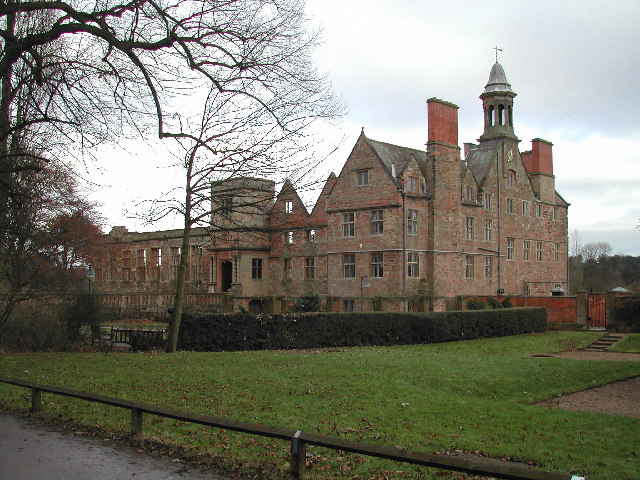- Rufford Abbey
Geobox|Abbey
name = Rufford Abbey
category = House & estate

image_caption =Rufford Abbey
symbol = Standard of the English Heritage.svg
country =England
state =Nottinghamshire
region =East Midlands
district =Newark and Sherwood
municipality =Ollerton
location = 2 miles South ofOllerton off A614
elevation =
prominence =
lat_d =
lat_m =
lat_s =
lat_NS =
long_d =
long_m =
long_s =
long_EW =
length =
length_orientation =
width =
width_orientation =
height =
depth =
volume =
area =
author =
style =
material =
established =1147 as a Cistercian Monastery
date =
owner = English Heritage
public =
visitation =
visitation_date =Open All year round
10am to 4pm
January to Februaey 10am to 4pm
free =
free_type =
map_caption =
map_background =
map_locator =
map_locator_x =
map_locator_y =
website =http://www.english-heritage.org.uk/server/show/nav.11940
footnotes =Rufford Abbey is an estate in
Sherwood Forest inNottinghamshire ,England .The Monastic Foundation
The abbey itself was founded by Gilbert de Gant in, or around,
1147 and populated withCistercian monks fromRievaulx Abbey inYorkshire .The English Pope,
Adrian IV gave the blessing for the abbey in 1156 and following this the abbey' lands expanded and the villagers ofCratley , Rufford,Grimston andInkersall were evicted. A new village of Wellow, just outside the estate housed some of the displaced people. [ [http://www.friendsofrufford.org.uk/history.htm Friends of Rufford] accessed9 May 2008 ]The
Valor Ecclesiasticus of 1534 gives the gross income of the abbey as £254 6s. 8d. and the clear annual value as £176 11s. 6d.Abbot Doncaster obtained a pension on the dissolution of the house in
1536 among the lesser monasteries, of £25 a year; but it was voided on his speedy appointment to the rectory of Rotherham on2 July 1536 . ; Abbots of Rufford
* Philip de Kyme, temp. Stephen
* Edward, occurs 1203
* Geoffrey, occurs temp. John, 1218, &c.
* Thomas
* Simon, occurs 1232
* G—, occurs 1239
* Geoffrey, occurs 1252
* William, occurs 1259
* Henry, 1278
* Thomas de Stayngreve, occurs 1283
* Henry, occurs 1288
* Henry de Tring, occurs 1315
* Elias Lyvet (Levett ), occurs 1332 [ [http://books.google.com/books?id=Tb-a-E1oCOkC&pg=PA306&lpg=PA306&dq=%22elias+lyvet%22+rufford&source=web&ots=yhMZcFYtvs&sig=OILE0brXflsMzdTuNxIw0oQ5d1o&hl=en&sa=X&oi=book_result&resnum=2&ct=result#PPA306,M1 The Heads of Religious Houses, England and Wales, Vol. II, 1216-1377, David M. Smith, Vera C.M. London, Cambridge University Press, 2001] ]
* Robert de Mapelbek, 1352
* Thomas, 1366
* John de Harlesay, 1372
* John de Farnsfeld, 1394
* Thomas Sewally, occurs 1400
* Robert de Welles, 1421
* Robert Warthill, died 1456
* William Cresswell, 1456
* John Pomfrat, died 1462
* John Lilly, 1462
* John Greyne, 1465
* Roland Bliton, 1516
* Thomas Doncaster, last abbotLater owners
The estate was later granted to the Talbot family, and its residents included
George Talbot, 6th Earl of Shrewsbury . In 1626, the house was sold to Sir George Savile, and later inhabited by his descendant, the Marquess of Halifax.The Savile family sold the estate during the
Great Depression , and it was later acquired byEnglish Heritage . The late 17th century North Wing was demolished in the 1950s.Ice Houses
Between 1729 and c.1845 many improvements were made to the Rufford estate. For example; the addition of the bath house, the creation of the lake and mill buildings, the construction of the brewhouse, water tower and coach house and also the addition of five icehouses.
Rufford Abbey once gave home to five ice houses, however, only two still remain today. All were constructed c1820, when the estate was owned by John Lumley-Savile, 8th Earl of Scarbrough (1788 – 1856). The five ice houses are located near Rufford lake, created c1750; this means that the ice houses were built in close to the lake purposely, for the simple reason that the movement of ice from its source was easier.Not all of Rufford’s Ice Houses faced north, as accessibility and the logistics of the ice may have meant that the builders found it easier to place the doorways facing the lake rather than northerly. See
Icehouse (building) . It is believed that ice was mainly taken from Blackwalk Pond, which was drained to make way for housing in the 20th century (Blackwalk Pond was used to serve the abbey in Rufford's monastic era, later it fed Rufford's water tower and brew house, still on the site today).The 1851 Poaching Incident and Ballad
In 1851, a gang of forty or so poachers assembled in Rufford Park as a mass action against what was perceived to be the unfair monopolisation of game-hunting rights by wealthly landowners. The poachers were attacked by ten gamekeepers and, in the ensuing battle, one of the gamekeepers was badly injured and later died of a fractured skull. Four of the poachers' ringleaders were arrested and each subsequently sentenced to deportation and fourteen years of penal servitude for manslaughter. The incident gave rise to the popular ballad, "Rufford Park Poachers" (Roud #1759), which depicts the poachers as bold heroes. [ [http://www.goldenhindmusic.com/lyrics/RUFFPARK.html Rufford Park Poachers] accessed
11 July 2008 ] [ [http://www.mustrad.org.uk/articles/bbals_17.htm Rutterford the Poacher] accessed11 July 2008 ]TV Series
One thing that many people may know of was its setting for the children's book and later TV series called 'Polly Flint' in the mid 80's. The small close-by village of Wellow was also used.
Music
"Rufford Abbey" is a popular piece composed and arranged for Brass Band by D. Rimmer (note: not William Rimmer, renowned for his marches). It is often used as an intermediate grade competition piece, and is a popular choice for recitals.
References
ee also
* [http://www.newadvent.org/cathen/13220c.htm Catholic Encyclopedia article]
* [http://www.rotherhamweb.co.uk/h/rufford1.htm Rufford, Rotherham.co.uk]
Wikimedia Foundation. 2010.
